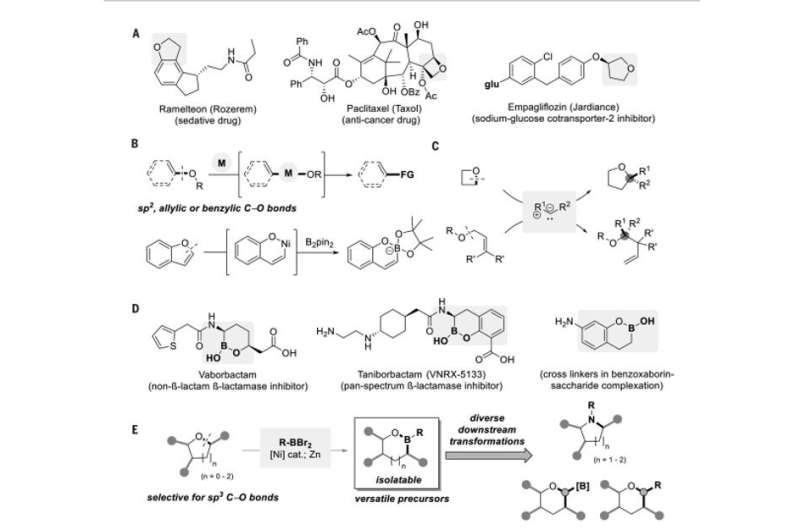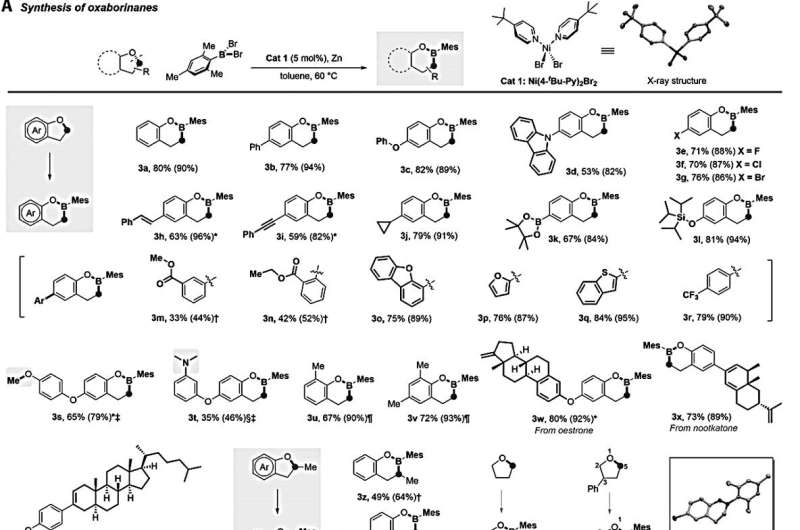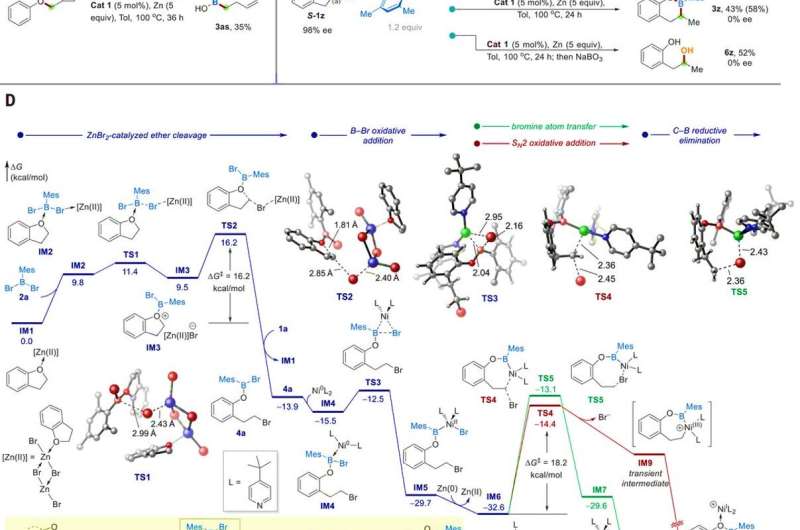Functionalization of ether bonds. (A) Small-molecule drugs containing cyclic ether moieties. Ph, phenyl; Ac, acetyl; Bz, benzoyl; glu, glucose. (B) Transition metal–catalyzed C−O cleavage via oxidative addition. R, alkyl; M, transition metal; FG, functional group; B2pin2, bis(pinacolato)diboron. (C) Carbene insertion into activated ethers. (D) Cyclic boronate derivatives as drug candidates or cross-linkers for biomedical materials. (E) This work: a Ni-catalyzed direct boron insertion via a cleavage-then-rebound pathway. Credit: Science, 10.1126/science.abg5526
The carbon-oxygen (C-O) bond in alkyl ethers can be cleaved using mild methods to simplify chemical syntheses by elaborating robust, readily available precursors. In a new report now on Science, Hairong Lyu and a research team in chemistry at the University of Chicago and the University of Pittsburgh, U.S. detailed how dibromoboranes reacted with alkyl ethers in the presence of a nickel (Ni) catalyst and zinc reductant to insert boron into the C-O bond. The subsequent reactivity affected the oxygen-to-nitrogen substitution to streamline the preparation of bioactive compounds more broadly. Using mechanistic studies, the team revealed a cleavage-then-rebound pathway via zinc/nickel tandem catalysis.
Ether moieties
Ether moieties are commonly found in feedstock and fine chemicals; for example, cyclic ethers are prevalent in a range of biologically important molecules including drugs, agrochemicals and natural products. Ethers also act as effective structural linkers to protect groups in organic synthesis due to their high chemical stability towards acids, bases, reductants and oxidants. A mild method that directly edits a moiety by replacing the oxygen or inserting an intervening atom into the C-O bond can conveniently introduce a new functional group into an existing scaffold in a strategically important step. Chemists can use robust ethers as surrogates for more sensitive chemical groups that can be installed later. Lyu et al. were inspired by recent advances in borylene chemistry to functionalize ether bonds by inserting an active borylene species.
Cleaving alkyl ether bonds
Conventionally, alkyl ether bonds can be cleaved under harsh and strongly acidic conditions. To establish a practical method in this work, Lyu et al. sought to avoid strong reductants, expensive catalysts and forced reaction conditions. The study therefore began with 2,3-dihydrobenzofuran as the model ether substate and dibromomesitylborane (MesBBr2) as the boron reagent. The bulky group prevented dimerization of reduced boron species to enhance the stability of the boron-insertion product for isolation. The combined nickel catalyst and zinc powder was most effective. The team ultimately obtained the desired boron insertion product 2H-benzoxaborin (labeled 3a) with 90% yield in toluene solution at 60 degrees Celsius. The reaction pathway was starkly different; they used an air-stable tetrahedral Ni (II) complex abbreviated (Cat 1 molecule) and confirmed its structure using x-ray crystallography to highlight its superiority to other Ni pre-catalysts or other metals. In the absence of Cat1, they noted less than 1 percent yield of 2H-benzoxaborin and a ring-opening alkyl bromide intermediate (abbreviated as 4a) to form in high yield. Other nickel complexes also gave the desired product, although in much lower yield. Lyu et al. noted similar efficiency using an in situ generated nickel catalyst (abbreviated as L1). Given the critical role of the nickel catalyst, the team also examined other nitrogen-based ligands. The monodentate ligands acted better than bidentate ligands (labeled L1 to L7 and compared with L8 to L12). For example, 3-methyl pyridine (L5) exhibited slightly lower reactivity, while most other monopyridines (L2, L3, L4 and L6) as well as oxazoline (abbreviated L7) were comparatively less effective. They also used zinc powder as an essential catalyst and noted the progression of the boron-insertion reaction at a low reaction rate at room temperature.
Nickel-catalyzed borylation of cyclic ethers. (A) Synthesis of oxaborinanes via direct borylation of fivemembered cyclic ethers. Me, methyl; Ar, aryl. (B) Synthesis of oxaborepans via direct borylation of sixmembered cyclic ethers. Ts, tosyl. (C) Synthesis of oxaborolanes and azaborolidine via direct borylation of cyclooxabutanes and azetidine. (D) Synthesis of the oxazaborolidine via direct borylation of 4-phenyl-morpholine. (E) Synthesis of borinic acids via direct borylation of linear ethers. Reactions were conducted with 0.2 mmol ether, 0.24 mmol MesBBr2, 0.01 mmol Cat 1, and 1 mmol zinc powder in 0.5 ml of toluene at 60°C under nitrogen for 24 hours. Isolated yields after silica gel chromatography are given; the numbers in parentheses are nuclear magnetic resonance yields before purification. *Reaction was run at 80°C. †Reaction was run at 100°C. ‡0.2 mmol MesBBr2 was used. §Reaction was run at 130°C. ¶Ni (PMe3)2Cl2 (0.01 mmol) was used as the catalyst, and the reaction was run at 130°C for 18 hours. Reaction time was 36 hours. Credit: Science, 10.1126/science.abg5526
The ether scope during the boron-insertion reaction
Lyu et al. examined the ether scope for the boron-insertion reaction. For instance, a range of substituted 2,3-dihydrobenzofurans reacted with MesBBr2 (dibromomesitylborane) smoothly to form the desired boron-insertion products with good to excellent yields. For example, substrates bearing halogens including fluorine (F), chlorine (Cl) and bromine (Br) underwent nickel catalyzed cross-couplings to form 2H-benzoxaborins (labeled 3e to 3g) with more than 70 percent yield. Among a myriad of molecules thus formed, the team noted the tolerance of both pinacol boronate and silyl ether moieties during this reaction. Further control experiments will show how primary alkyl chloride is fully compatible, while primary alkyl bromide was partially compatible under reaction conditions. Additionally, the primary alkyl fluoride was not tolerated due to its strong boron-fluoride interactions. Lyu et al. then derived complex substrates from terpene natural products that smoothly underwent the boron-insertion reaction and delivered desired products in 3-folds or higher. Additionally, tetrahydrofuran also gave the expected mono boron-insertion product (labeled as 3ab) in 69 percent yield. When the team used the unsymmetrical 3-phenyl-tetrahydrofuran as a coupling partner, the boron insertion occurred regioselectively in the less bulky position to indicate the influence of sterics.
Boron-insertion into more complex molecules.
Lyu et al. additionally conducted boron insertion into more-strained oxetanes, as well, to provide an entry to five-membered oxaborolanes (labeled 3ai to 3aj). The compromised selectivity resulted in linear side-products. From the vantage point of synthetic practicality, the team showed how the B-Mes (boron-mesityl) bond could easily undergo one-pot hydrolysis via the addition of water in methanol to provide the corresponding hydroxyl boronate products that are more stable in air. The scientists functionalized cyclic boronates from readily available 2,3-dihydrobenzofurans in one step to develop analogs of an approved antifungal drug known as tavaborole and crisaborole, an approved drug to treat dermatitis.
Synthetic elaboration. (A) Rapid access to cyclic boronates via one-pot hydrolysis. The boronate products (5a to 5c) are substantially more stable toward air and moisture. (B) Further functionalization of the borylation product through derivatization of the C−B bond. Bn, benzyl. (C) O-to-N editing to access pyrrolidines and piperidines from tetrahydrofurans and tetrahydropyrans, respectively. (D) Three approaches for one-carbon ring expansion of cyclic ethers. DIAD, diisopropyl azodicarboxylate. (E) Streamlined synthesis of the antihypertensive drug nebivolol. For detailed reaction protocols. Credit: Science, 10.1126/science.abg5526
Other reactions
The boron moiety in the insertion products could also be conveniently converted into various other functional groups. For instance, the team could treat the crude product (3a) 2H-benzoxaborin, with hydrogen peroxide to obtain 1,2-tyrosol (6a) in excellent yield. The Suzuki-Miyaura coupling of the 3a molecule with bromo-benzene efficiently formed o-phenethylphenol (labeled as 7a). The method also allowed efficient one-carbon ring expansion reactions and provided boron-retentive ring expansion. During the experiments, the nature of the alkyl group in the coupling reaction and the role of the nickel catalyst were key to understand the subsequent steps of carbon-boron bond formation.
Mechanistic studies. (A) Identification of the reaction intermediate. (B) Radical-clock experiment. (C) Control experiments with a 98% ee substrate. (D) Computed energy profile of the catalytic borylation of ether 1a. Calculations were performed at the M06/SDD-6311+G(d,p)/SMD(toluene)//B3LYP-D3/SDD-6-31G(d) level of theory. Inset shows proposed Zn/Ni tandem catalysis. Credit: Science, 10.1126/science.abg5526
Outlook
In this way, Hairong Lyu and colleagues demonstrated a method for boron insertion into alkyl ether bonds under the catalysis of nickel and zinc. Since ethers are readily available and robust substates, the boron-insertion method can also streamline the synthesis of complex target molecules by minimizing the functional group manipulations or by protecting group usages. The distinct reaction mode revealed by the mechanistic studies can have implications on Lewis acid/transition metal tandem catalysis reactions that are beyond this work.
More information: Lyu H. et al. Boron insertion into alkyl ether bonds via zinc/nickel tandem catalysis, Science, 10.1126/science.abg5526
Jingjing Wu et al. Synergy of synthesis, computation and NMR reveals correct baulamycin structures, Nature (2017). DOI: 10.1038/nature23265
Namirembea S. & Morken J. P. et al. Reactions of organoboron compounds enabled by catalyst-promoted metalate shifts, Chemical Society Reviews doi.org/10.1039/C9CS00180H
Journal information: Chemical Society Reviews , Nature , Science
© 2021 Science X Network



























